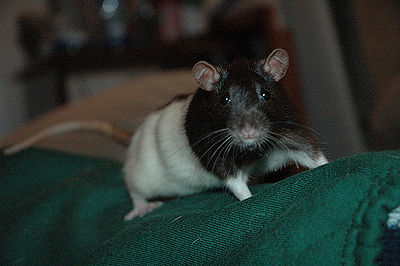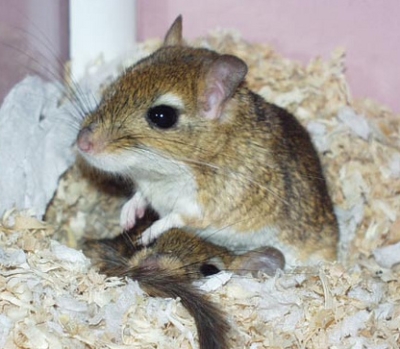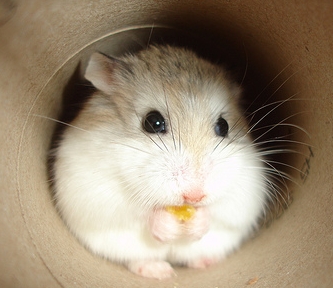
Contents |
Are Rats the Right Pet for You? Basic Information
If you’re in the process of exploring whether or not rats are a good choice of pet for you, here is a wealth of information and resources so you can make an informed decision.
If you have decided that you do indeed want a rat, you have several options of where you can find your new furry friends.
- You can look up postings online on different websites in your area of people wishing to rehome their rats
- You can contact a reputable breeder and obtain a rat through them
- You can go to your local SPCA or rescue organization and adopt a rat from them that needs a home
Please do not support pet stores and do not buy a pet through them. In doing so, although you are saving two rats from pain and potential suffering, you are supporting rat mills and irresponsible breeders.
What do Pet Rats look like?
Pet rats are varied in color including black, white, chocolate, cinnamon etc. They can also have various markings. Hair can be short,long, curly, fine, rough and even hairless. There are also two “dumbo” rats, which have larger ears that are offset from the head as compared to standard rats. Typically, “fancy rats” is the title given to domesticated pet rats. Life span is about 2-3 years.
For more information on colors and markings of rats, please see FancyRats Wiki
What is the personality of a Pet Rat?
Rats are very social and should at least be kept in pairs. Rats should never be without a cage mate, unless the rat has proven to be aggressive towards other rats. Rats are more mellow than mice and more intelligent. They enjoy being held and are easier to train. If a rat escapes, they often return to their cages if it is reachable. Paper towel and toilet rolls make fund toys for them to nibble on. As with all rodents, they love to gnaw and there are many wooden toys available for them.
Males tend to be more calm and peaceful and usually make a better “lap rat”. Females, on the other hand, tend to be more energetic and fun loving.
Contrary to popular belief, male rats will not fight with each other as cage mates providing they have been properly introduced. For introducing rats, introducing younger rats to older ones is a much easier practice than introducing older rats together who have not already lived together.
Rat Behavior
Just like human beings, rats come in all shapes and forms. This also includes varying personality quirks and different behaviors. When in doubt about something you rat(s) are doing, do some online research or talk to your veterinarian. You may also wish to consult Rat Behavior and Biology
Happy rats engage in “bruxing”, which is equivalent to a cats purring. When a rat bruxes, they are grinding their teeth together. However, if bruxing is louder than normal, it can also be a sign that the rat is in pain because rats typically can hide their pain and illness very well as part of their prey mentality.
Another sign of a happy rat is “boggling” which is quite the sight to see, quite literally! Boggling happens when intense bruxing pushes their eyeballs slightly out of their socket – so the rat looks temporarily a bit bug eyed. This is nothing to be concerned about but it can be a bit alarming for new rat owners to witness! It is simply a sign of extreme contentedness.
Rats are prey animals and sometimes, when frightened, they may nip. To discourage this behavior, try gently rubbing your finger around your rat’s face. Always approach your rat speaking softly without making any sudden moves.
Rats are very intelligent and can find their ways into, and out of plenty of tight spaces. They will also systematically destroy objects within their grasp if they think it may be tasty or delicious. So if you have any valuables within reach of your rats, you may wish to move them out of harms way.
One reason that it is not recommended that a rat be housed alone is because their behavior can be negatively impacted. A solitary rat is more likely to become depressed and withdrawn and can also become more aggressive. Rats need companionship that no human owner can provide – they need another rat for grooming, cuddling and having fun together with.
Rats are capable of being trained to use a litter box, as well as can be trained to do some tricks and can be trained to come when their name is called. It does require a lot of patience to train an animal, but rats are very driven to perform, especially when a treat is used as an incentive.
- What is my rat doing? FAQs
- Trust training rats
- Bonding with your rat
- Litter training your rat
- Different kinds of rat bites
- How to spot an angry rat
Information about why rats need company:
Cage Recommendations
Whatever cage you decide on, it should be strong enough to withstand the Rat’s chewing. For appropriate sizing, a rat requires a fair amount of space. It is best to consult a Rat Cage Calculator to determine whether a specific cage is appropriate for two or more rats. The cage floor should be solid and bars of the cage close enough that the Rats won’t get stuck (as well, look for a powder coated bars which are typically white. They are less likely to rust and are easier to clean).
Rats are notoriously good climbers and will be very happy with taller cages, providing you also have ramps because as the rats age their agility slowly declines.
For cage decoration essentials, rats love hammocks. They will eat in, sleep in, and generally destroy hammocks. A happy rat is one who has quite a few hammocks and other toys available (for other toys, you could consider tubes, kleenex boxes, toilet paper tubes, and wooden things they can gnaw on).
Rats are capable of being litter trained, but in the event that you choose not to do this, you must select an appropriate litter and bedding for your rats. Rats have very sensitive respiratory systems, and strong scents are not healthy for them. As such, it is wise to avoid wood chip beddings that are comprised of oily or aromatic woods/trees. Some owners choose to go with a newspaper bedding, but the inks in newspaper can be toxic to rats (as rats will likely ingest some of the bedding). A good alternative to wood chip bedding or newspaper is called CareFresh and can be found at most petstores. Another popular alternative is called Yesterdays Newsand it is a recycled newspaper pellet which is safe for animals (it is generally marketed toward cat owners, so you may find it in that aisle in your local petstore).
Rat Diet and Nutrition
Rats will eat a wide range of food, but careful feeding will keep your pet healthy. While a rat ‘can’ eat most anything, that does not mean that they SHOULD eat most anything.
For the staple part of their diets, seed mixes sold in pet stores are NOT recommended because they are nutritionally incomplete – a rat is able to pick out what they want to eat and will leave the rest. As such, a product such as Oxbow Regal Rat (a fortified food pellet), Mazuri (a lab block), or Harlan Teklad (has many different forms of lab block available) is preferable.
If you choose to not feed your rat a commercial product such as Regal Rat, Mazuri or Harlan Teklad, a homemade mixture called “Suebees Mix” is an acceptable alternative. Suebees mix is homemade and is a mix of: low fat dog food (seniors mix generally), dried rolled oats, puffed wheat cereal, Total (a brand of healthy cereal found in the US and Canada) unsalted soy nuts, dried fruits, uncooked pasta and a few sunflower seeds. Do NOT replenish your rats supply of food until they have finished everything – a rat will not let itself starve to death, but must learn to finish all of its food before it gets more.
Nuts and sunflower seeds can be fed in small portions, but they are highly fatty and should be fed only sparingly or as an occasional treat. Too much fat or protein in a rats diet can lead to skin problems, weight issues and other health concerns.
In conjunction with the staple pellets/lab blocks or Suebees Mix, a rats diet should also include : dog biscuits, bread, vegetables and small pieces of cooked meat. You can offer your rat a shank bone and untreated wood toys to help keep teeth trimmed and satisfy the need for chewing. Fresh water should always be available.
There are several types of foods that should NOT be fed to rats because they can lead to illness or death, so you should also consult the Forbidden Foods List.
For more information about a rats diet, please consult your veterinarian or a reliable source, such as this: Rat Guide: Diet information
- Information on Suebees Rat Diet
- Information on the Shunamite Rat Diet (another form of a homemade mix)
- link to Oxbow’s website
- link to Mazuri’s website
- link to Harlan Teklad’s website
Rat Health and Well-Being
Before deciding to bring a rat into your home, you should seek out a small animals or exotics vet in your area that feels comfortable providing veterinary services for rats and other rodents. Rats have a different physiology than other small “pocket pets” and require different care as a result. For more information about how to choose a good vet, please see Choosing a Vet. If you are unsure of whether you can financially afford veterinary care, it would likely be best to choose a furry friend that is not as prone to different illnesses such as rats. Rats need veterinary care as much as a cat, dog or any other family pet.
Rats are prone to respiratory infections, such as ‘myco’. It is an easily treated illness providing it is caught early enough, and is treated through a prescribed medication. For more information about myco (Mycoplasma pulmonis) please see here: Respiratory Illnesses in Rats
Some symptoms of a respiratory illness in your pet rats include : excessive (or new) sneezing, rattling sound when breathing, red staining (porphyrin) around nose or eyes, swelling (appearance) of eyeball or around eye, cloudy eye(s), swelling in neck area, a puffy face, noticeable weight loss and lethargy. If you notice any of these symptoms that come on quickly, your rat has a respiratory illness (or another issue) and needs veterinary assistance IMMEDIATELY.
Rats can also be prone to tumors, both benign (non-cancerous) and malignant (cancerous). Especially female rats are prone to mammary tumors, however this likelihood can be reduced through spaying your female rats. Male rats can be neutered in cases of tumors, and this could also be a viable solution for instances of rat aggression due to hormones. Surgeries to remove tumors have varying degrees of success, so it is best to find a veterinarian who is comfortable performing such a surgery should the need arise.
What is bugging your pet? If you see your rat scratching more than usual, notice profound fur loss, or see scabs or little bugs crawling on your rats – you likely have a bug problem. Don’t worry, it is easily treated with a quick trip to the vet. Rats can come into contact with mites or lice through many different means – including other rats or contaminated bedding. Chances are, that if you can see little red moving dots on your rats, you likely are dealing with lice, whereas mites are nearly invisible to the human eye. Do NOT treat your rats with an over the counter drug that is for treating mites or lice in cats and dogs. Rats can be easily poisoned because dosing is very difficult to determine with such a small animal. Lice are species specific, meaning that if you have head lice they will not transfer to your pet, nor vice versa. Mites are considered host specific, but may switch to another species host if their preferred host species is not available. If you have a mites problem, talk to your vet to see if you need to be treating other animals in your house to prevent another infestation. A veterinarian will generally provide a topical medication to be put on the fur/skin of all of your rats. This is because even rats not showing symptoms of being affected by bugs likely ARE infested, they just may have a stronger immunity to them.
Other medical problems that you may experience when owning rats (certainly not an exhaustive list):
1. Malocclusion. Crooked teeth, teeth that may be growing in incorrectly or that the rat is not grinding down through bruxing can be quite dangerous to their health. Crooked teeth can impact a rats ability to eat, and left untreated can puncture or lacerate their mouth. It is generally easily treated with a vet visit, where the veterinarian will either cut down the teeth so they grow properly or may require surgical correction or teeth removal.
2. Abscesses. Quite different than a tumor, but they can both be fairly easily mistaken for the other by a rat owner. It is almost the equivalent of a zit or pimple in a rat, but is far bigger and can be more difficult to deal with. It is a pus filled pocket, that can either drain by itself naturally without medical care, or may require a vet visit.
3. Megacolon. Pretty much explanatory by the term, it is generally found in younger rats. It is typically fatal, because it is a blockage in the colon. This is the result of a genetic disorder typically found in poorly bred rats. If you notice your rat seems to be eating less than usual and has developed a more rotund stomach and looks bloated and acts abnormally – get to a veterinarian IMMEDIATELY.
4. Ear infections. Usually one of the immediate symptoms of a rat having an ear infection is a pronounced head tilt as well as coordination issues. If treated early, these symptoms can be reversed but may persist long after the infection has been medically treated with prescription medications.
5. Bleeding from the vagina or rectal area of a rat. Common misconception: RATS CANNOT MENUSTRATE. If you see *any* blood coming from that area on a rat, regardless of their sex – get them to the hospital immediately. Rats do not have a large volume of blood, and any blood loss is not good. Bleeding from their genitals can be caused by any number of issues, including urinary tract infections, kidney infections or kidney stones, internal tumors or ruptures in the reproductive organs. If you notice any blood around the genitals of a rat, take it to the vet IMMEDIATELY otherwise you are risking the life of your rat.
6. Degloving, otherwise known as “tail issues”. Degloving occurs sometimes when a rats tail gets stuck somewhere, and upper portions of the epithelial layer (skin layer) come off. This is alarming to see, and can result in portions of the tail falling off. This is another reason why you should never grab your rat by its tail, because it can break off and it does not regenerate or grow back.
7. Foot issues, including bumblefoot and toenail problems. Bumblefoot (ulcerative pododermatitis) is a sore or ulcer that grows from the underside of the rat’s hind foot. It is unknown what causes these sores, but it could be the result of obesity in rats, walking on wet or unclean bedding, or walking on cage bars (which is why the bottom of your cage should be solid and not bars). It is treated with a medical cream that is prescribed by your veterinarian. Another common foot issue involves problems with a rats toenails. While most rats can dull their nails by walking around their cage and outside their cage, it can also create more sharp nails which can hurt their owners! When a rats nails get too long, they can also get caught on different things and can rip off or tear, which is exceedingly painful for the rat. If this happens to your rat, apply a wet compress to the foot, or flour and water until the bleeding has ceased. The torn nail will probably fall off, but it will regrow in time. When a torn nail happens, it is important that the bleeding is stopped because rats have a limited blood supply and could bleed to death as a result.
For other health concerns related to rats, please check out the Rat Guide to Health
First Aid Kit for Rats
Since rats are prone to many forms of injury or illness, it is always best to be prepared with a homemade first aid kit. Here are some examples of general necessities in a first aid kit.
Hydrogen Peroxide – good for cleaning out wounds.
Styptic Powder – good for occasions when you can’t stop a wound (like a torn toenail) from bleeding. If you don’t have this, always have flour and water on hand.
Children’s Chewable Aspirin – dose it according to a rats weight, good for times when a rat has a fever.
Skin Glue – good to use when rats have small gashes that need to be closed.
Scissors and toenail clippers – Good for trimming down toenails and for cutting up bandages and other essentials when needed.
Cotton Balls and Q-Tips – Cotton Balls are good to be used with hydrogen peroxide when swabbing a wound, and q-tips are good for smaller wounds and holes, as well as cleaning out ears if there is a minor issue.
Syringes – Find ones that are small, and come without needles. This is very important when you get a medical prescription from the vet for an oral antibiotic.
Water-soluble doxycycline – shouldn’t be used unless you’re an expert at rat care, but it is used in treating upper respiratory infections and can sometimes be purchased without a prescription.
For more ideas about what to include in a first aid kit, please see
Resources and Websites to Check Out
All information provided here is as accurate as possible, but should not take the place of professional advice from a veterinarian. The following websites provide useful information on topic areas not covered in this Wiki article and should also be consulted to gain the most knowledge of proper pet rat care.
- Pet Info Packet: Rats
- Poisonous Plants for Rats
- Forbidden Foods for Rats
- Rat Guide
- Rat Health Guide
- Rat Care Guide
- Rat Medication Guide
- Rat Balls: Rats are People too!
- Rats Rule
- Pet Rats Canada
- Fancy Rats information for UK owners
- Rat & Mouse Club of America (RMCA)
- America Fancy Rat & Mouse Association (AFRMA)
- Pet Rat Info
- Especially for Newbies (E4N) Rat Info
- Ratz R Us
- RattyRat.com
- Rat Palace
- RMCA Resources
- Rats Rule: Rat Care Primer
- Fat Rat Central
- The Rat Fan Club
- Rat Fan Club: Help Info
- Virginia’s Rat Page
- Rat Help & Questions
- Rats as Pets: What You Need to Know About Pet Rats
- Fancy Rats: FAQs
- Rat Drug Usage Chart
- Rat Facts
Videos
–Canders7 03:37, 29 November 2009 (UTC)



